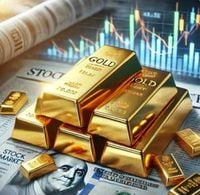On April 7, 2025, international gold prices continue to decline, significantly impacting the domestic gold market in South Korea. The uncertainty surrounding the U.S. Federal Reserve's interest rate policies and concerns over a global economic slowdown are major factors contributing to the drop in gold prices. As of this morning, international gold is trading at $3,037 per ounce, a notable decrease from last week’s peak of $3,135. This decline has prompted analysts to interpret the current market as entering a short-term correction phase.
In South Korea, domestic gold prices are also experiencing a downturn. According to the Korea Exchange, as of April 7, the price of gold is approximately 528,263 won per gram, which represents a 13.9% decrease from the recent high of 613,238 won recorded within the past year. This trend reflects a broader pattern observed in the global market.
Experts attribute the recent drop in gold prices to the potential delay in U.S. interest rate cuts and a recovery in risk appetite across global financial markets. As investors regain confidence, the demand for gold, traditionally viewed as a safe haven, has temporarily diminished. In light of these developments, investment strategies focusing on diversification have gained traction among investors.
Hwang Byung-jin, a researcher at NH Investment & Securities, noted that gold and silver prices typically weaken when real interest rates rise. He explained, "Generally, when the Federal Reserve's monetary policy shifts to a tightening stance, we witness a clear decline in gold prices. The recent adjustments in gold and silver prices are largely due to temporary cash demands amid fears of an economic slowdown." He further stated, "Currently, gold is viewed as a low-price buying opportunity, with a target price of $3,300 per ounce for the year."
Market observers are also noting the impact of geopolitical tensions and the ongoing tariff policies implemented during the Trump administration, which continue to create uncertainty in the global economy. The tariffs, particularly those imposed on China, have led to increased tensions that disrupt global supply chains and could further slow economic growth.
On April 7, 2025, the prices for various precious metals in South Korea also reflect this downward trend. The buying price for pure gold (24K, 3.75g) is 614,000 won, down 4,000 won from the previous day, while the selling price stands at 530,000 won, a decrease of 2,000 won. Similarly, the selling price for 18K gold (3.75g) is 391,000 won, down 1,000 won, and 14K gold (3.75g) is priced at 303,000 won, also down by 1,000 won.
Platinum prices have similarly declined, with the buying price for 3.75g of platinum at 181,000 won, down by 4,000 won, and the selling price at 154,000 won, also down by 4,000 won. Silver prices have followed suit, with buying and selling prices for 3.75g at 5,700 won and 5,400 won, respectively, each down by 250 won.
Despite the current downturn, experts suggest that the long-term outlook for gold remains positive. The ongoing geopolitical uncertainties, such as the conflict in Ukraine and tensions in the Middle East, have led to increased purchases of gold by central banks worldwide, further driving demand. Additionally, the potential for stagflation in the U.S.—characterized by stagnant economic growth alongside inflation—could bolster gold's appeal as a safe investment.
In recent weeks, the gold market has seen fluctuations driven by profit-taking among investors. As global stock markets faced declines, liquidity shortages prompted some investors to liquidate their gold holdings to secure cash. This trend was evident last week when gold futures at the New York Mercantile Exchange dropped by 2.9% to close at $3,024.2 per ounce, with spot prices dipping as low as $3,015 during trading.
Moreover, the dynamics of the market are being influenced by the recent tariff policies, which have exempted gold and other precious metals. This exemption has led to expectations that gold previously directed toward the U.S. market may flow back into the global market, potentially stabilizing prices.
As the financial landscape continues to evolve, investors are advised to closely monitor market trends and exercise caution in their investment decisions. A representative from the financial investment sector remarked, "It is essential to focus on gold's role as a long-term asset defense strategy rather than just short-term price adjustments. Investors should observe market flows carefully and make prudent investment choices."
In summary, the current decline in gold prices reflects a complex interplay of economic factors and market sentiments. While short-term adjustments are occurring, the long-term prospects for gold remain promising, particularly as global uncertainties continue to shape investor behavior and demand for safe-haven assets.




![[오늘의금시세] 4월 6일, 주요 금속 가격 전반적으로 하락 : 네이트 뉴스](https://thumbor.evrimagaci.org/Z88Cijur0sCgJFkmEwxwnJBIrnI=/200x0/tpg%2Fsources%2Fb5de28d0-3544-4e7d-aa12-5dbee6a98f59.jpeg)



